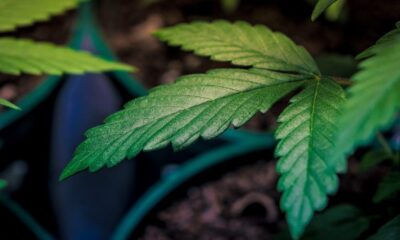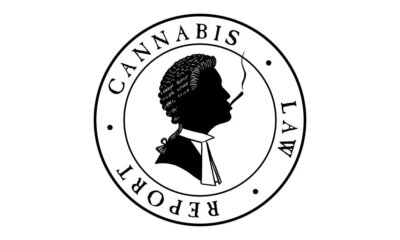featured
A Brief Global History of the War on Cannabis
Published
2 days agoon
I want a Goddamn strong statement on marijuana … I mean one on marijuana that just tears the ass out of them. … By God we are going to hit the marijuana thing, and I want to hit it right square in the puss. … I want to hit it, against legalizing and all that sort of thing.
—Richard Nixon, 37th president of the United States
Before the war on drugs put marijuana farmers firmly in its crosshairs, cannabis was being grown openly and with commercial success on every continent on earth, much as it had been for centuries.
This ancient and extensive history of cannabis farming has given rise to the idea that prohibitions put in place in the mid-20th century were the first of their kind — a whirlwind of racial, political, and economic forces that successfully used marijuana prohibition as a pretext for suppression. By contrasting prohibition with our ancient history of cannabis farming, some historians make our modern-day drug laws appear irregular and shortsighted. In his seminal (and controversial) book on cannabis, “The Emperor Wears No Clothes” (referred to by many legalization advocates as “the Hemp Bible”), Jack Herer opens with the following line:
For thousands upon thousands of years, all over the world, whole families came together to harvest the hemp fields at the height of the flowering season, never dreaming that one day the U.S. government would be spearheading an international movement to wipe the cannabis plant off the face of the earth.
Yet, while unprecedented in scope, the United States’ war on drugs was not the first of its kind. The reality is that marijuana has been controversial for almost as long as humans have been farming it. Many societies throughout history have banned cannabis cultivation and use. What many of these crackdowns and prohibitions have in common is social and economic inequality, or a distrust of the unknown. When members of a minority or lower class embrace marijuana use, the ruling class moves to outlaw marijuana as a form of suppression and control. Marijuana is perceived to be a threat to the order of society, and stamping it out naturally begins with a prohibition on cultivation.
A Look At The Ancients
As a case in point, the ancient Chinese might have been the first cannabis farmers — and, as far as we know, were the first to write about psychoactive marijuana — and yet they may also have been the first to reject it as a socially acceptable drug. The rise of Taoism around 600 BCE brought with it a cultural rejection of intoxicants. Marijuana was then viewed as antisocial, and derisively dismissed by one Taoist priest as a loony drug reserved for shamans. The sentiment persisted into the modern era — to this day, marijuana struggles to disassociate itself with the stained history of opium in China.
Muslim societies have a complex relationship history with marijuana. Hashish use spread widely with the expansion of Islam in the seventh century CE, and remains popular today. Early Arabic texts referred to marijuana as the “bush of understanding” and the “morsel of thought.” Yet traditional theologians believed Mohammed prohibited marijuana use (the Koran [2: 219] prohibits “intoxicants,” but how that word should be interpreted is still up for debate). One prominent theologian associated marijuana with the dreaded Mongol empire, and many upper-class Muslims pushed for prohibition, for fear that marijuana use would disrupt the labor force. In the end, some societies tolerated marijuana use or turned a blind eye; others (such as Damascus in 1265) embraced prohibition.
Sufi Muslims took these tensions to the next level. The mystical Sufis believed that spiritual enlightenment could be reached by an altered state of consciousness, and a mind-bending drug like marijuana would seem a logical vehicle to reach that state. Sufis believed hashish was a vehicle not only to personal enlightenment but to direct communication with Allah. These beliefs did not go over well with the rest of mainstream Islam, however. To make matters worse for the Sufis, they were often lower-class laborers. That marijuana use was therefore central to a religion perceived to be a heretical challenge to religious, economic, and political order made the plant an easy target for authorities.
In 1253, Sufis were openly growing marijuana in Cairo, Egypt. The government, claiming that Sufism was a threat to society, raided their farms and destroyed all their crops. Undeterred, the Sufis made deals with farmers in the Nile River Valley to grow marijuana on their farmlands. This successful agricultural partnership lasted until 1324, when Egyptian troops raided the countryside and destroyed all the marijuana they could find. For Sufis and marijuana farmers, the situation only got worse. Martial law was imposed in 1378, and this time the authorities destroyed more than marijuana crops: entire farms and farming villages were burned to the ground. Farmers were imprisoned or executed, and hashish users had their teeth pulled. Despite this swift and vicious crackdown, the demand for hashish remained strong. The cycle of cultivation, consumption, and crackdown continued in Egypt for centuries.
Christianity and Cannabis
Islam was not the only major world religion to feel threatened by marijuana. Pope Innocent VIII issued a papal ban on cannabis in the first year of his papacy, in 1484. At the time, marijuana, along with other mind-altering plants, was being cultivated for medicinal and spiritual applications throughout Europe by pagans who were considered to be witches and sorcerers. The Christianity of Pope Innocent VIII, however, was predicated on a future fulfillment in the afterlife, and a rejection of momentary pleasures or enlightenment. The pagans growing marijuana profoundly challenged this premise by promising spiritual enrichment in the present, with a plant grown right here on earth. Pope Innocent VIII thus wasted no time in addressing this existential threat, declaring cannabis to be an unholy sacrament of the satanic Mass. The pagans who cultivated it were persecuted into imprisonment, exile, or death.
Colonial empires, with their unfailing concern for a robust military and hard-working labor force, have often viewed marijuana with suspicion. Though the Spanish were one of the first colonial empires to encourage the cultivation of hemp in the Americas, they were not as enthusiastic about marijuana. The Spanish governor of Mexico issued an order in 1550 limiting cannabis farming because “the natives were beginning to use the plant for something other than rope,” write Robert Clarke and Mark Merlin in their book “Cannabis: Evolution and Ethnobotany.” White South Africans, descended from Dutch or British colonialists, passed a series of laws in the 19th century designed to crack down on the cultivation and use of marijuana by indentured Indian farm workers, who were viewed by whites as societal contaminants and a threat to civil order.
The Portuguese empire also struggled to control cannabis. The Portuguese wanted to foster a strong hemp-producing workforce just like those of their colonial rivals, but they considered marijuana a pernicious vice, especially when used by slaves. The Portuguese introduced marijuana prohibitions to many of their African colonies, including Zambia and Angola. Nonetheless, explorers to the region noticed marijuana being grown “nearly everywhere” and used by “all the tribes of the interior,” according to a report published by the Transnational Institute.
When the Portuguese brought slaves to Brazil in the 16th century, the slaves brought marijuana along with them, as seeds were sewn into the clothing they wore onto the slave ships and then germinated upon arrival. Whatever strains they were using must have been well adapted to the Brazilian landscape; marijuana was soon growing from the coasts to the Amazon and everywhere in between. For the most part, marijuana cultivation was permitted during Portuguese rule. But when Brazil gained its independence in the early 19th century, Rio de Janeiro’s municipal cannabis prohibition started a chain reaction of prohibitions around the country aimed at curbing marijuana use among slave populations.
One reason Portugal may have been lenient on marijuana farming in Brazil is the fact that the Queen of Portugal herself was using it while stationed there during the Napoleonic wars. This wasn’t the first time Napoleon Bonaparte was involved in the history of marijuana. Several years earlier, in 1798, Napoleon had launched the French campaign into Egypt and Syria, a large-scale offensive designed to cut off British trade and liberate Egypt from Ottoman rule. After the initial conquest, Napoleon attempted to maintain local support by embracing Islamic culture and scientific exchange. An unusually large percentage of French forces in Egypt (totaling around 40,000) were scientists and scholars, and were responsible for establishing libraries, laboratories, and research centers that went on to make significant contributions in a number of disciplines.
The discovery of hashish may not have been seen as a breakthrough at the time, but it had a great effect on European culture and literary thought. Prior to the French campaign in Egypt, hashish wasn’t well known in Europe and certainly wasn’t commonly used. The 40,000 French troops stationed in Egypt, however, quickly learned about it. Hashish was ubiquitous in Egypt at the time, bought and sold in cafés, markets, and smoking lounges. Lacking access to their customary French wines and liquors and encouraged by Napoleon to embrace Egyptian culture, many French troops took up hashish.
Hashish
Unfortunately, hashish was still associated with Sufi mystics and looked down upon by the Sunni elite. After Napoleon went back to France, the general he had left in charge of Egypt, General Jacques-François Menou, was a noble-born French revolutionary who married into an upper-class Sunni family after taking command of Egypt. For Menou, the prospect of a hashish ban killed two birds with one stone: It would appease the Sunni elite by cracking down on Sufis, and alleviate a perceived public health problem among the French troops. The ordre du jour banning the cultivation, sale, and consumption of cannabis, considered by some scholars to be the first drug prohibition law in the modern era, came down in 1800. It opens with the following:
Article One: The use of strong liquor, made by certain Muslims with a certain grass [herbe] called hashish, and smoking of the seed of cannabis, are prohibited throughout Egypt. Those who are accustomed to drinking this liquor and smoking this seed lose reason and fall into a violent delirium, which often leads them to commit excesses of all kinds.
Whether or not Menou’s order was the first modern penal law on drugs, it largely failed to work (a fact that should come as no surprise to us in the 21st century). Hashish continued to be produced, sold, and consumed widely throughout Egypt, and it came home with French troops when they left Egypt in 1801. It wasn’t long before hashish was being widely used in France and the rest of western Europe.
Despite efforts by authorities in Europe to paint hashish as an unstable and dangerous substance, many of the Romantic period’s most accomplished artists and writers were brought together because of cannabis. Dubbing themselves Le Club des Hachichins (Hashish-Eaters’ Club), luminaries such as Théophile Gautier, Charles Baudelaire, Gérard de Nerval, Victor Hugo, Honoré de Balzac, and Alexandre Dumas would meet in Paris to take hashish and exchange notes on their experiences. They rejected mainstream attempts to associate hashish with what was regarded as Oriental barbarism and, through their writings, normalized marijuana use and popularized the Romantic era’s bohemian creed: l’art pour l’art (art for art’s sake).
Across the Channel, the British Empire wrestled with the conspicuous presence of cannabis in India. As a native plant to the Indian subcontinent, cannabis could be found growing in the wild by hunter-gatherers, and was likely cultivated by the earliest agrarian settlers. Psychoactive marijuana strains featured prominently in early texts of the Hindu, Buddhist, and Tantrist religions. As the Indian marijuana farming industry matured over time, the harvested product was divided into three gradients, all of which remain available today.
Bhang is the cheapest, most prevalent, and lowest-quality marijuana; it consists of crushed leaves, seeds, and/or flowers, and produces the least potent high. On the other end of the spectrum, Charas is the highest-quality and most expensive marijuana in India. It is sold as a highly potent hashish produced from plants grown in the most desirable cannabis-producing farmlands of the Hindu Kush and Himalaya mountain ranges between 4,000 to 7,000 feet. It remains one of the most revered marijuana products in the world today. Somewhere in between Bhang and Charas is Ganga. A mid-grade crop in both price and potency, Ganga is cultivated from well-cared-for female plants, and consists of a mixture of resin and cannabis flower.
One of the first Europeans to write about the Indian marijuana industry was a Portuguese doctor named Garcia da Orta. He wrote of Bhang in 1563:
The Indians get no usefulness from this, unless it is in the fact that they become ravished by ecstasy, and delivered from all worries and cares, and laugh at the least little thing. After all, it is said that it was they who first found the use of it.
Some 200 years later, the British mulled over the possibility of a marijuana prohibition in India. The Indian ruling class and the British governor-general of India pushed for a total ban, fearful that marijuana would create social unrest. The British Parliament, however, had other ideas. Short on cash, the government saw the marijuana industry as an opportunity to raise some revenue. They taxed cannabis in 1790, and three years later, established a regulatory framework to issue licenses to farmers and sellers.
The tax-and-regulate scheme worked to some extent. But in a vast landscape where cannabis grows in the wild, many farmers and their crops escaped the tax. The British encouraged the regulatory system to decentralize, allowing cities and states to experiment with different taxation schemes. The results were mixed. The strength of the black market was frustrating enough that the British Parliament considered prohibition measures in 1838, 1871, 1877, and 1892. But ultimately the measures failed to pass, because the tax revenues that did come in couldn’t be ignored.
Temperance movement advocates persisted, however, driven by the evils of opium use which they associated with cannabis. Parliament responded by commissioning the most comprehensive government study of marijuana in human history. The seven-volume 3,500-page “Report of the Indian Hemp Drugs Commission” of 1894 to 1895 called over a thousand witnesses from around the world. The findings emphatically rejected the alleged grounds for prohibition. The commission found (as its predecessors did) that marijuana cultivation is nearly impossible to eradicate, and argued that it produces no “evil results” in the first place:
Prohibition
Total prohibition of the cultivation of the hemp plant for narcotics, and of the manufacture, sale, or use of the drugs derived from it, is neither necessary nor expedient in consideration of their ascertained effects, of the prevalence of the habit of using them, of the social and religious feeling on the subject, and of the possibility of its driving the consumers to have recourse to other stimulants or narcotics which may be more deleterious.
The commission went on to recommend a tax-and-license scheme for the marijuana farming industry:
The means to be adopted for the attainment of [control and restriction] are:
- adequate taxation, which can be best effected by the combination of a direct duty with the auction of the privilege of vend;
- prohibiting cultivation, except under license, and centralizing cultivation.
This may represent the first time in history a government study has recommended a centralized marijuana farming scheme. Comprehensive as it is in other respects, however, the commission’s report does not elaborate on this centralization proposal; it merely suggests that the most effective way of limiting supply is “to grant licenses for cultivation in such a way as to secure supervision and registration of the produce.”
Despite the commission’s efforts, Parliament’s endorsement of its report was lukewarm. As a result, the marijuana farming trade continued unchanged, with taxation and licensing of cultivators continuing to be hit and miss. Bhang was informally grown nearly everywhere; Ganga crops were, for the most part, produced on government-licensed farms; and Charas was imported from the Hindu Kush and Himalayas. This basic structure persisted into the global prohibition era of the 20th century. The proposal to “centralize cultivation” was largely forgotten after the commission’s report was published. But a century later, government regulators trying to find their way through the post-prohibition era of the 21st century would come to recognize its advantages.
***
The history of marijuana farming tells us that when prohibitions are imposed, they almost always come from the ruling class. Marijuana’s role as a spiritual, medicinal, or recreational drug of the poor working classes stokes fears among the elite that the political, religious, or economic order that has served them so well may be disrupted. There aren’t, therefore, many cases where marijuana was embraced by the ruling class and persecuted from below. But the story of the Bashilange tribe suggests that marijuana users can be targeted from any angle.
In the mid-19th century, the eastern region of the Democratic Republic of the Congo in central Africa was a vast wilderness, and it was controlled by the Bashilange tribe. The Bashilange were ruthless fighters, eating the bodies of their victims and enslaving their prisoners. They enacted few laws, save a requirement that other tribes in the region pay tribute to their supremacy or face a certain death. While exploring these lands, however, the Governor of German East Africa observed a remarkable shift in the Bashilange’s culture. The tribe had discovered marijuana, and rapidly embraced the plant as a pillar of their tribe’s identity.
Tribesmen of the Bashilange dubbed themselves the Sons of Cannabis, and soon passed laws to promote peace and friendship. They rejected cannibalism and were no longer permitted to carry weapons in the village. They stopped killing their rivals, and started having more sex. Marijuana was smoked regularly and at most important events, including religious ceremonies, holidays, and political alliances. Formerly known for being cold-blooded killers, the Sons of Cannabis became tranquil marijuana-growing peacemakers.
Unfortunately, their rivals did not share the Sons of Cannabis’s newfound love of peace and friendship. Many tribes lost respect for their former rulers and stopped making tribute payments. With weakening support in the region, the Bashilange tribe splintered. The Sons of Cannabis, no longer the fearsome fighters of yore, were overthrown by their fellow tribesmen who yearned for a return to the tribe’s dominant past. The new regime reinstituted the tribe’s violent practices, and largely returned the Bashilange to its former warring nature.
Jack Herer may have been using hyperbole when he claimed that cannabis farmers throughout history could not have conceived of the 20th century’s crackdown on marijuana. The historical record illustrates that while many regions of the world have tolerated or embraced marijuana farming in the past, plenty of others have seen authorities attempt to exterminate farmers and their crops. Targeting the first step in the supply chain is a logical starting point for prohibitionists, and marijuana’s role as an agent of religious, political, or economic change has long made it a threat to the established social order.
Our marijuana-farming ancestors of the past could have told us, based on experience, that when prohibitionists come after cannabis, they will do so in predictable ways. They will use rhetoric to associate the plant with violence, depravity, and other more dangerous drugs, as the European temperance movement did in France and Great Britain. They will use a militarized show of force to eradicate crops, persecute farmers, and dissuade the next generation from growing marijuana, as the Ottomans did in Egypt. They will portray marijuana users as religious extremists or dangerous minorities, as Pope Innocent VIII did in Europe, Sunni Muslims did in the Middle East, or white South Africans did in South Africa. The best-case scenario, they might say, is that the authorities will turn a blind eye to the unstoppable forces of supply and demand, much as the Portuguese did in Brazil or the British did in India.
In telling us this, our marijuana-farming ancestors might as well have been writing the playbook for the 20th-century war on drugs. The cannabis prohibition era in the United States did not invent this “greatest hits” collection of tactics that prohibitionists have been using for centuries; it simply brought them all together in one place, and injected them with more financial and military resources than any prohibition movement in history has ever seen.
***
Ryan Stoa is an associate professor of law at the Concordia University School of Law and the author of “Craft Weed,” from which this article is adapted.

Author: mscannabiz.com
MScannaBIZ for all you Mississippi Cannabis News and Information.
You may like
-


Marijuana Users In Iowa Are Engaged And Active Citizens, Survey Shows—Smashing ‘Lazy Stoner’ Stereotypes
-


Here’s Where To Buy Legal Recreational Marijuana In Delaware Next Month
-


Fireworks, marijuana and cash found in Bronx apartment – NBC New York
-


How often are marijuana cases federally prosecuted?
-


A Brief History of Getting High
-


Rhode Island Marijuana Regulators Seeking Applications For New Dispensary In State’s Northern Region
featured
Marijuana Users In Iowa Are Engaged And Active Citizens, Survey Shows—Smashing ‘Lazy Stoner’ Stereotypes
Published
49 minutes agoon
July 6, 2025
“Many of today’s cannabis consumers are ‘middle American’ adults, employed, own a home, vote regularly, pay their taxes and are involved in their communities.”
By Bob Sillick, Iowa Capital Dispatch
For many years, cannabis users were characterized as a cult of stoners: young, often unemployed, party animals. That sector still exists in some form, however, many of today’s cannabis consumers are “middle American” adults, employed, own a home, vote regularly, pay their taxes and are involved in their communities.
That is the general profile of adult cannabis consumers across the country and in Des Moines, according to a recent survey by Consumer Research Around Cannabis/The Media Audit.
The Media Audit, the parent company of Consumer Research Around Cannabis, is an international research company serving 80+ local markets in the U.S. and Canada for more than 20 years. It started gathering data about cannabis use and attitudes in 2016.
Although the sale of adult recreational cannabis is illegal in Iowa, the survey found 16.2 percent of all adults age 18+ in Des Moines said they used or bought cannabis during the past month, or the statistical equivalent of approximately 140,000 adults.
The smallest percentage in the following table, monthly usage in Des Moines, is still substantial—and suggests a pent-up market. Unleashing the recreational cannabis market in Des Moines and all of Iowa would likely generate jobs and significant taxes for the state—money now escaping across the borders.

The survey data from Des Moines and 42 other markets was aggregated and showed 24.1 percent of adults 18+ used or bought cannabis during the past month. (Local factors affect these percentages and comparisons.)
For 15 years, Jonathan Caulkins, H. Guyford Stever professor of operations research and public policy at Carnegie Mellon University’s Heinz College, has been studying cannabis legalization. He is also the author of several books on the topic and a member of the Commission on the North American Opioid Crisis.
Caulkins’s research fine-tunes the results of the Des Moines survey from Consumer Research Around Cannabis.
“From 1992 through 2023, the most recent year for which we have released data, the trend has been towards an enormous increase in the number of people who are using cannabis daily or near daily. They account for 80 percent of recreational cannabis sales. They dominate the market,” Caulkins said.
In states like Iowa that haven’t legalized adult recreational cannabis, Caulkins expects when they do, the middle of the market will be blue-collar high-school graduates, adults 25–40 who are employed but not affluent.
He has also seen a gender trend as more states allow the sale of recreational cannabis.
“As cannabis has become more legal, the male/female use gap has become noticeably smaller. When it was an illegal action or a risky action, there was a much bigger gender gap, but that gap is declining. Use by men is increasing with legalization, use by women is increasing even more,” he said.
Cannabis consumers in Des Moines also align with the 43-market survey when comparing gender and income. Millennials at 42.3 percent and Gen Xers at 35.5 percent account for three-quarters of the adult cannabis consumers in Des Moines who bought or used cannabis during the past month. These percentages are slightly more than the 43-market survey at 41.5 percent and 28.2 percent, respectively. The 33.8 percent of cannabis consumers in Des Moines with household incomes of $35,000 to $75,000 is also slightly more than the 43-market survey at 29.6 percent.
The Consumer Research Around Cannabis data also profiles cannabis consumers at a more granular level. The “household profile” category shows which three were the largest purchasers or users of cannabis during the past year, or 33.8 percent collectively.
- Affluent, no children at home: $75,000+ household income
- Affluent white-collar worker: Family income $100,000+
- Affluent Boomers: $100,000+ household income
Comparing cannabis purchasers and users in Des Moines with the 43-market survey by their employment status and occupation reveals some contrasts. The data indicates that many in Des Moines are working and contributing to the local economy.

Voting is a meaningful measure of civic responsibility. Millennials at 22 percent, Gen Xers at 54.4 percent and Baby Boomers at 12 percent who purchased or used cannabis during the past month voted in local, state and national elections, compared to 33 percent, 32.1 percent and 24.6 percent, respectively, in the 43-market aggregate survey.
This particular data point may have ramifications for future legislative efforts to legalize adult recreational cannabis sales in Iowa. While the Iowa Legislature’s majority Republicans have rebuffed Democrats’ proposals to legalize recreational marijuana, advocates suggest time may be on their side if an increasing body of citizens support legalization with their votes.
Marijuana’s Schedule I Status ‘Traps Researchers In A Paradox,’ Federally Funded Scientists Say

Author: mscannabiz.com
MScannaBIZ for all you Mississippi Cannabis News and Information.
featured
Here’s Where To Buy Legal Recreational Marijuana In Delaware Next Month
Published
2 hours agoon
July 6, 2025
All seven medical marijuana operators have converted to adult-use cannabis sales, with over 10 locations, which will be up and running in August.
By Brianna Hill, Spotlight Delaware
Delaware will begin recreational marijuana sales on August 1, state officials announced Tuesday, putting the first definitive date on the start of a long-awaited rollout for the $280 million industry.
Customers on that first day will be heading to existing medical marijuana businesses though, as the burgeoning legal market has yet to develop the dozens of new businesses licensed for recreational-only sales.
That decision has already sparked criticism from advocates and residents, who say it puts other businesses at an unfair disadvantage.
For years, medical marijuana dispensaries have denied that they sought the handful of licenses available at the time in order to get a first-adopter advantage for the eventual recreational market. But now that is occurring.
“The existing medical marijuana dispensaries lobbied for less competition and to begin sales before new businesses, and now, with the [Office of the Marijuana Commissioner]-caused delays, they will end up with first sales and absolutely no competition,” Zoë Patchell, president of the Delaware Cannabis Advocacy Network, which advocated for years for legalization, wrote in a Facebook post.
Delaware medical marijuana dispensaries

Jacob Owens, Spotlight Delaware / Source: Delaware Office of the Marijuana Commissioner / Created with Datawrapper
- First State Compassion–Wilmington, 37 Germay Drive, Wilmington http://firststatecompassion.com
- First State Compassion–Lewes, 12000 Old Vine Blvd., Unit 102, Lewes
- http://firststatecompassion.com
- Fresh Cannabis, 635 N. Dupont Blvd., Milford
- https://freshdelaware.com/
- Columbia Care Delaware, 200 S. DuPont Blvd., Smyrna
- https://col-carede.com/
- Columbia Care Delaware, 5606 Concord Pike, Wilmington
- https://col-carede.com/
- Columbia Care Delaware, 36725 Bayside Outlet Drive, Suite 760, Rehoboth Beach
- https://col-carede.com/
- Field Supply, 4543 Kirkwood Highway, Wilmington
- https://thefieldsupply.com
- Fresh Cannabis, 800 Ogletown Road, Newark
- https://freshdelaware.com/
- Fresh Cannabis, 22983 Sussex Highway, Seaford
- https://freshdelaware.com/
- The Farm, 105 Irish Hill Road, Felton
- https://www.thefarmde.com
- The Farm, 240 S. Dupont Highway, New Castle
- https://www.thefarmde.com
- Best Buds, 516 Jefferic Blvd., Dover
- https://www.bestbuds.com
- Best Buds, 23 Georgetown Plaza, Georgetown
- https://bestbuds.com
Delaware’s adult-use marijuana industry, which was legalized in 2023, allowed for 125 licensees to operate throughout the state across cultivation, manufacturing, testing and retail sales. The operators were chosen at the end of last year through a lottery system that saw more than 1,200 individuals apply.
Entering the licensing lottery alone required individuals to submit detailed applications and fees. Most application fees cost $5,000, with the active license itself costing up to $10,000.
Medical marijuana operators seeking to enter the recreational market were required to pay steep conversion fees—$100,000 for retail or manufacturing licenses and $200,000 for cultivation.
The state used the revenue to create a $4 million reimbursement fund for social equity applicants, defined as individuals with prior marijuana-related convictions or those from communities disproportionately impacted by prior marijuana enforcement.
Since March, business operators have been awaiting clarity from the Office of the Marijuana Commissioner (OMC), the state office in charge of regulating the industry, on when sales could legally begin.
The market’s launch was originally slated for April but faced delays after the state failed to secure FBI approval to conduct background checks on licensees.
As of June 18, 43 individuals have cleared their background checks, according to OMC spokeswoman Keila Montalvo. The office did not respond to requests for information on how many conditional licenses have been issued.
Even as an official date is set, state lawmakers are still trying to revise the law that made recreational sales legal.
The law permitted municipalities to prohibit marijuana businesses from their jurisdictions and gave counties broad authority to dictate where they could locate, but those allowances have led a third of Delaware towns and cities to opt out of allowing marijuana shops and Sussex County to place significant restrictions on locations.
A bill to lessen those restrictions has passed both the House and Senate and now awaits consideration from Gov. Matt Meyer (D).
All seven medical marijuana operators have converted to adult-use cannabis sales, with over 10 locations, which will be up and running in August.
Given the ongoing barriers faced by other licensees, including strict local zoning rules, delayed funding for social equity applicants and pending conditional license approvals, the early start for medical marijuana businesses could give them a major head start in shaping the market.
“Our focus is on building a safe, equitable, and accountable marijuana market that delivers real benefits to Delawareans. We will continue to issue conditional licenses to previously selected applicants to ensure they can begin operations once active,” Joshua Sanderlin, Delaware’s new marijuana commissioner, said in a statement.
This story was first published by Spotlight Delaware.
8 In 10 Marijuana Consumers Use It As A Substitute For Prescription Drugs, New Survey Finds

Author: mscannabiz.com
MScannaBIZ for all you Mississippi Cannabis News and Information.
Nowadays, people tend to associate the cannabis plant with Mexico, and for good reason. For decades, narcos smuggled their harvests into the United States and Europe. Along with California, Mexico is known to produce some of the finest cannabis in the world. The states of Sinaloa, Nayarit, Jalisco, Michoacán, Guerrero, Oaxaca, Chihuahua, Sonora, and Durango—where the largest farms are located—all have climates that are perfect for cultivating cannabis: year-round temperature ranging between 70 and 85 degrees Fahrenheit, with cool, long nights and low humidity.
But long before cannabis was introduced to—and became synonymous with—the New World, it was being cultivated in the lands of Central Asia. Initially, though, the cannabis or hemp plant was grown not for its leaves but for its stems, which could be processed into a strong and durable rope.
Excavations reveal that humans have been using hemp rope since the Neolithic age. The earliest evidence for burning cannabis, meanwhile, dates back to 3,500 BC, and is attributed to the Kurgans of modern-day Romania. This Proto-Indo-European tribe probably burned the plant as part of their rituals and ceremonies, a practice that spread eastward as its practitioners migrated. Why the Kurgans burned cannabis is difficult to say. They may well have discovered the plant’s psychoactive properties by accident, only to find that the smoke heightened their connection with all things spiritual.
The earliest evidence for smoking cannabis comes from the Pamir Mountains in western China. There, in 2500-year-old tombs, researchers discovered THC residue inside the burners of charred pipes that were probably used for funerary rites. (Similar pipes, dated to the 12th century BC, were later found in Ethiopia, left there by a separate culture). These devices, compared to pyres, would have yielded a much stronger high. Given their placement inside a crypt, however, it’s safe to say they were used only ceremonially, not recreationally.
Some scholars have argued that cannabis was an important ingredient of soma, a ritual drink concocted by the Vedic Indo-Aryans of northern India. Described in the Rigveda, a collection of ancient Sanskrit hymns, soma was made by extracting juice from an unknown plant. When taken in small doses, soma was reported to induce a feeling of euphoria. In higher doses, it caused people to see hallucinations and lose their sense of time. All three of these effects have been ascribed to cannabis, but even if cannabis was not the main ingredient of soma, it may have been combined with psychedelics such as psilocybin, a.k.a. magic mushrooms.
Aside from rope, cannabis was most often processed into medicine. When the Hindus of India came down with a case of “hot breath of the gods,” healers treated the illness with cannabis smoke. The logic behind this treatment was not exactly scientific; cannabis was thought to possess healing powers because it was the favorite food of the supreme godhead Shiva, also called “Lord of Bhang.” In reality, cannabis would have been able to reduce fevers because its active ingredient, THC, works on the hypothalamus to lower body temperature.
The Assyrians used cannabis not in a medical but in a religious context, burning it in their temples to release an aroma that supposedly appeased their gods. Sources from the region refer to cannabis as qunubu, providing a possible origin for the word we use today. The Assyrian Empire was conceived in the 21st century BC and lasted until the 7th. During this time, it engulfed much of modern-day Iraq as well as parts of Iran, Kuwait, Syria and Turkey. Through trade and conquest, Assyrian traditions spread to neighboring societies, including the Dacians, Thracians and Scythians, the latter of which were among the first to consume cannabis in a distinctly recreational manner.
The Scythians were part of a Central Asian nomadic culture that flourished from 900 to around 200 BC. Originating in northern Siberia, Scythian tribes settled as far as the shores of the Black Sea, where they came into contact with the ancient Greeks. When Scythians died, their friends and family burned hemp inside tents to commemorate their passing. While the Kurgans and Assyrians burned their cannabis out in the open or in large indoor spaces, the Scythians were essentially hotboxing themselves at every funeral. At least, that’s the image we receive from the historian Herodotus, who wrote that “the Scythians enjoy [the hemp smoke] so much that they would howl with pleasure.” And so, the primary purpose of this ritual was to send off the dead; it clearly also served to entertain the living.
Herodotus did not live among the Scythians, but his observations seem to have been confirmed by excavations. Archeologists discovered fossilized hemp seeds at a Scythian camp in western Mongolia that were left there between the 5th and 2nd century BC.
Romans, too, consumed cannabis for their own pleasure, but not in the way you might expect. Like many societies of classical antiquity, they harvested the plant for its seeds rather than its leaves, which were discarded as a waste product. When grounded, the seeds were used in medicine. When fried, they were served up as delicacies during lavish dinner parties. Roman chefs mentioned cannabis seeds in the same breath as caviar and cakes. Galen, the famous Roman physician, wrote that they were consumed “to stimulate an appetite for drinking.” Nowadays, it’s the seeds—not the leaves—that are considered useless. However, the Romans believed they, too, had some intoxicating properties; Galen adds that, when consumed in large amounts, the seeds would send people into a “warm and toxic vapor.”
Cannabis was so widely consumed in classical antiquity that people raised the same questions and concerns we are debating today. The Greek physician Pedanius Dioscorides, for instance, wrote that the plant’s spherical seeds, “when eaten in excess, diminish sexual potency.” Modern-day cannabis users are all too aware of the connection, even if they don’t eat seeds. As stated by Healthline, cannabis is “often associated with side effects that may affect sexual health, including erectile dysfunction.” Similar to some psychedelics, the general sense of euphoria generated by cannabis may counteract or override the reception of sexual stimuli.
Let’s skip forward a bit. Recreational smoking became especially popular after the 9th century AD. In the Middle East and Western Asia, the followers of Islam took up the habit for the simple but somewhat amusing reason that their holy scripture, the Quran, forbade the consumption of alcohol and various other intoxicating substances. Fortunately for Muslim stoners, the Quran did not say anything about weed. Of course, they smoked not just any weed, but hashish.
Skipping forward again, this time to the 16th century—the century that cannabis arrived in the New World, and for the sole purpose of making rope, no less. Actually, Americans did not start smoking weed until about one hundred years ago, when Mexican immigrants entered the country to seek refuge from the Mexican Revolution. For decades, the U.S. government turned a blind eye on this harmless, multicultural and age-old practice. However, this changed during the Great Depression, when Washington redirected the anger of unemployed workers to their Mexican brethren. After millennia of peaceful consumption, cannabis was suddenly decried as an “evil weed,” and, in 1937, the U.S. became the first country in the world to criminalize cannabis on a national level.
The rest, at this point in time, has now become history as well.
Original publication: 2022

Author: mscannabiz.com
MScannaBIZ for all you Mississippi Cannabis News and Information.

Marijuana Users In Iowa Are Engaged And Active Citizens, Survey Shows—Smashing ‘Lazy Stoner’ Stereotypes

Here’s Where To Buy Legal Recreational Marijuana In Delaware Next Month

Fireworks, marijuana and cash found in Bronx apartment – NBC New York

How often are marijuana cases federally prosecuted?
A Brief History of Getting High

Rhode Island Marijuana Regulators Seeking Applications For New Dispensary In State’s Northern Region

Texas Medical Marijuana Industry Wants Lawmakers To Ban Synthetic Delta-8 THC And Restrict Hemp Products To Adults

California Cannabis Operators Warn That New Tax Hike ‘Could Kill This Industry’
High Times Greats: Jim Morrison

New cannabis tax increase is a high concern for California dispensaries, customers
A Brief History of High Times (2019)

Georgia veterans suffering from PTSD push for medical cannabis expansion on Fourth of July
A Brief Global History of the War on Cannabis
The Evolution of Cannabis in Film
High Times Is Home Again
Dope As Yola Becomes First Weedtuber to Hit 2 Million Subscribers

$20M worth of cocaine, marijuana seized in Caribbean Sea: USCG
Will Success Spoil Cheech & Chong? Of Course (1980)
Prescription-Only Rule Takes Hold Amid Political Ouster

Marijuana Use Is Tied To ‘Significantly Higher Sexual Desire And Arousal,’ New Study Shows
Flashback Friday: Psychedelic Cacti

Trump’s VA Secretary Is ‘Particularly Proud’ Of Psychedelic Research Aimed At Helping Veterans With PTSD

Democratic Senate Sponsor Of Marijuana Banking Bill Says Budget Issues And War Have Delayed Cannabis Reform Efforts

Tifton Police: About 20 pounds of marijuana discovered during traffic stop

Alert: Department of Cannabis Control updates data dashboards with full data for 2023

Connecticut Appoints The US’s First Cannabis Ombudsperson – Yes there is a pun in there and I’m Sure Erin Kirk Is Going To Hear It More Than Once!

5 best CBD creams of 2024 by Leafly

Free delta-9 gummies from Bay Smokes

EU initiative begins bid to open access to psychedelic therapies
New Study Analyzes the Effects of THCV, CBD on Weight Loss

Mississippi city official pleads guilty to selling fake CBD products

May 2024 Leafly HighLight: Pink Runtz strain

Curaleaf Start Process Of Getting Their Claws Into The UK’s National Health System – With Former MP (Resigned Today 30/5/24) As The Front Man

5 best autoflower seed banks of 2024 by Leafly

Horn Lake denies cannabis dispensary request to allow sale of drug paraphernalia and Sunday sales | News

Press Release: CANNRA Calls for Farm Bill to Clarify Existing State Authority to Regulate Hemp Products

Local medical cannabis dispensary reacts to MSDH pulling Rapid Analytics License – WLBT

Discover New York’s dankest cannabis brands [September 2024]

Nevada CCB to Accept Applications for Cannabis Establishments in White Pine County – “Only one cultivation and one production license will be awarded in White Pine County”

6 best CBD gummies of 2024 by Leafly

The Daily Hit: October 2, 2024

5 best THC drinks of 2024 by Leafly

5 best delta-9 THC gummies of 2024 by Leafly

Weekly Update: Monday, May 13, 2024 including, New Guide for Renewals & May Board meeting application deadline

People In This State Googled ‘Medical Marijuana’ The Most, Study Shows

Thailand: Pro-cannabis advocates rally ahead of the government’s plan to recriminalize the plant

PRESS RELEASE : Justice Department Submits Proposed Regulation to Reschedule Marijuana

Press Release: May 9, STIIIZY and Healing Urban Barrios hosted an Expungement Clinic & Second Chance Resource Fair
Trending
-

 California Cannabis Updates1 year ago
California Cannabis Updates1 year agoAlert: Department of Cannabis Control updates data dashboards with full data for 2023
-

 Breaking News1 year ago
Breaking News1 year agoConnecticut Appoints The US’s First Cannabis Ombudsperson – Yes there is a pun in there and I’m Sure Erin Kirk Is Going To Hear It More Than Once!
-

 best list11 months ago
best list11 months ago5 best CBD creams of 2024 by Leafly
-

 Bay Smokes1 year ago
Bay Smokes1 year agoFree delta-9 gummies from Bay Smokes
-

 Business10 months ago
Business10 months agoEU initiative begins bid to open access to psychedelic therapies
-

 cbd1 year ago
cbd1 year agoNew Study Analyzes the Effects of THCV, CBD on Weight Loss
-

 Mississippi Cannabis News1 year ago
Mississippi Cannabis News1 year agoMississippi city official pleads guilty to selling fake CBD products
-

 California1 year ago
California1 year agoMay 2024 Leafly HighLight: Pink Runtz strain

